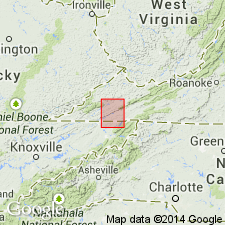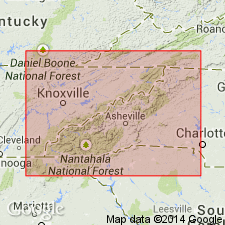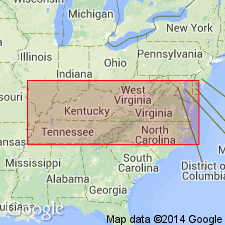
- Usage in publication:
-
- Unicoi sandstone*
- Modifications:
-
- Named
- Dominant lithology:
-
- Sandstone
- AAPG geologic province:
-
- Appalachian basin
Summary:
Name Unicoi sandstone credited to A. Keith. Described as heavy bed of coarse feldspathic sandstone or quartzite with exposed thickness of about 1,000 ft, but on its lower side bounded by a fault, so that full thickness cannot be determined. Underlies Hampton shale. Oldest formation in area.
Source: GNU records (USGS DDS-6; Reston GNULEX).

- Usage in publication:
-
- Unicoi Formation
- Modifications:
-
- Biostratigraphic dating
- AAPG geologic province:
-
- Appalachian basin
Summary:
Age constraints for the Vendian to Placentian Chilhowee Group are provided by, 1) the occurrence of Vendian acritarchs in the subjacent Sandsuck, Wilhite, and Shields Formations; 2) the first occurrence of PALAEOPHYCUS traces in the basal Cochran and Unicoi Formations; 3) the first occurrences of SKOLITHOS and PLANOLITES traces in the overlying Nichols and Hampton formations; 4) the abundance of well-developed arthropod as well as other diagnostic traces in the uppermost Nebo and overlying Murray Formations; 5) the recalculated age of 539ñ30 Ma for the Murray Formation; and 6) reported occurrences of late Placentian or younger body fossils recovered from the Murray Shale, including trilobites, ostracodes, inarticulate brachiopods, hylithoids, and acritarchs. The sequence in the Cochran-Unicoi interval where the Precambrian-Cambrian boundary is interpreted to occur consists of coarse-grained braided-fluvial sediments. It may prove impossible to locate the boundary precisely because of a lack of marine facies, and the shelly microfossils it might have provided.
Source: GNU records (USGS DDS-6; Reston GNULEX).

- Usage in publication:
-
- Unicoi Formation
- Modifications:
-
- Age modified
- AAPG geologic province:
-
- Appalachian basin
Summary:
The Chilhowee Group is probably Late Proterozoic (Vendian) to Early Cambrian (Placentian-equivalent or younger). A late Vendian(?) to early Placentian-equivalent (sub-Tommotian-equivalent) age is assigned to the Cochran and correlative Unicoi Formations. The Precambrian-Cambrian boundary is probably located somewhere within the uppermost portion of the Cochran/Unicoi interval.
Source: GNU records (USGS DDS-6; Reston GNULEX).

- Usage in publication:
-
- Unicoi Formation*
- Modifications:
-
- Age modified
- AAPG geologic province:
-
- Appalachian basin
Summary:
Age of Unicoi Formation of Chilhowee Group is Late Proterozoic and Early Cambrian based on limited radiometric and fossil ages. Placement of paleontological zonal boundaries is problematic. Because of facies patterns and rarity of body fossils, exact placement may never be resolved. In Mount Rogers area, Simpson and Sundberg (1987) recovered RUSOPHYCUS, a trilobite resting trace, from upper part of Unicoi and a hyolithid(?) from overlying Hampton Formation. Both require an Early Cambrian age. In TN, Walker and Driese (1991) placed Proterozoic-Cambrian boundary in upper part of Unicoi based on trace fossils. Similar vertical changes in trace fossil abundances occur in Chilhowee of central VA and are restricted to first appearance of inner-shelf deposits.
Source: GNU records (USGS DDS-6; Reston GNULEX).
For more information, please contact Nancy Stamm, Geologic Names Committee Secretary.
Asterisk (*) indicates published by U.S. Geological Survey authors.
"No current usage" (†) implies that a name has been abandoned or has fallen into disuse. Former usage and, if known, replacement name given in parentheses ( ).
Slash (/) indicates name conflicts with nomenclatural guidelines (CSN, 1933; ACSN, 1961, 1970; NACSN, 1983, 2005, 2021). May be explained within brackets ([ ]).

